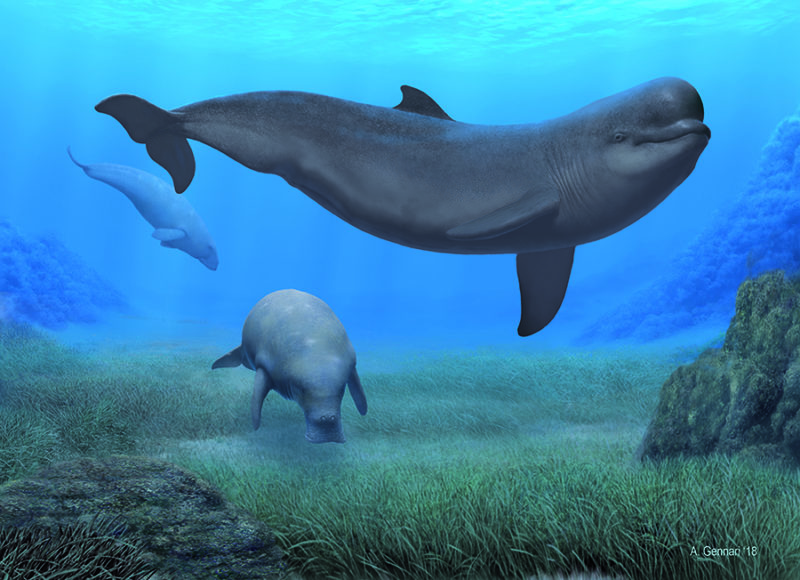The ancestors of the beluga and narwhal lived in the tropical waters of the Mediterranean

*Reposted with permission from University of Pisa*
The important discovery was led by the paleontologists of the University of Pisa thanks to a fossil of 5 million years ago found in Tuscany (Italy)
The beluga or white whale (Delphinapterus leucas) and the narwhal (Monodon monoceros) are two fascinating cetaceans that live exclusively in the cold Arctic waters, never departing from them, being the only extant relatives of the Monodontidae family. Nowadays, it is impossible to see these whales in the warm Mediterranean waters and even more absurd – so it was thought – that they could have lived in this sea at the beginning of the Pliocene, when the climate of the Mediterranean area was tropical. In turn, it happened. In Arcille, a small village near Grosseto (Tuscany, Italy), in a sand quarry, the fossil skull of a monodontid of about 5 million years ago was discovered. It was named Casatia thermophila. “Casatia” is a tribute to Simone Casati, discoverer of many important fossils of Tuscany (and, in particular, of the Arcille quarry), whereas “thermophila” means “lover of heat”, to emphasize that this cetacean lived in tropical waters.
The study, just published in the international Journal of Vertebrate Paleontology, was made by Giovanni Bianucci and Alberto Collareta, paleontologists from the Department of Earth Sciences of the University of Pisa, alongside with Fabio Pesci and Chiara Tinelli, who took part in the study in the framework of their thesis activities , respectively of master’s degree and doctorate. The discovery occurred during a paleontological excavation that also involved the Superintendence for the Archaeological Heritage of Tuscany, the Natural History Museum of the University of Pisa, and the GAMPS geopaleontological group (of which Simone Casati is president). The fossil is now exhibited in the recently renovated Cetacean Gallery of the Natural History Museum of Pisa.
“While a great deal is known about monodontid biology – explains Giovanni Bianucci – thanks to the research carried out on living belugas and narwhals by scientists from all over the world, very little is known about the evolution of these cetaceans, because their fossil record is extremely scarce. In fact, until now only three extinct species of monodontids were known, each of them was described on the basis of a single fossil skull. Therefore, the skull that we found in Arcille is of extraordinary importance not only because it is the first of monodontid discovered in the Mediterranean area, but also because it allowed us to describe the fourth fossil species of Monodontidae worldwide ”.
“But the scientific importance of this discovery – continues Bianucci – goes beyond the rarity of the discovery. The exceptional nature of the finding lies in the fact that, apparently, this fossil was found “out of place”, i.e. in an area of our planet where we never expected to find it. The reason beyond the absence of monodontids from the present-day Mediterranean is very simple: the waters are too warm and not suitable for cetaceans that have chosen the North Pole as their “home” and that never go beyond the Arctic Ocean. However, the most incredible aspect of this discovery relies in the fact that, about five million years ago, the Mediterranean was even warmer than now, with temperatures close to the tropical ones ”.
“The fact that the Mediterranean was a warm sea during the lower Pliocene has been known for some time – says Alberto Collareta – but other extraordinary fossils that we found in the quarry of Arcille support the hypothesis that Casatia thermophilaswam together with marine animals of tropical waters, such as the fearsome Zambesi shark (Carcharhinus leucas), the voracious tiger shark (Galeocerdo cuvier) and the enormous marlin (Makaira nigricans)”, all forms now absent from the Mediterranean.
“During monitoring of the Arcille quarry – adds Chiara Tinelli – we also recovered numerous sirenian skeletons referred to the fossil species Metaxytherium subapenninum, an ancestor of the dugong, a marine mammal that inhabits tropical coastal waters ”.
“Overall – Collareta continues – this fossil assemblage is indicative of a frankly tropical paleoenvironment, without analogues in the extant Mediterranean Sea. The discovery of Casatia thermophila within a similar paleoenvironment represents therefore the definitive confirmation that the narwhal and the beluga derive from forms of warm, tropical seas. It is probable that the two extant species of monodontids have evolved their extraordinary adaptations to cold waters in a very recent time, during the Quaternary (from about 2.6 million years ago to today), when the northern hemisphere was affected by repeated glaciations and a trend of progressive climatic degradation”.
“Studying the Arcille monodontid was really an important and formative experience for me” – says Fabio Pesci – Morphometric study and phylogenetic analysis were quite complex, at least for a student who experimented himself for the very first time in a research of this type. But it was exciting to find the data to support the fact that this fossil belonged to a monodontid species new to science “.
“The research we conducted in the Arcille quarry – concludes Bianucci – allowed us to discover only a small part of the extraordinary fossil heritage that is hidden in the Tuscan territory. The Tuscan hills represent, in fact, one of the areas with the highest concentration of fossils of marine vertebrates in the world. During the Pliocene, a large part of the Tuscan territory was submerged by a sea populated by a great variety of organisms. The deep geological and climatic changes that have occurred since then have reshaped the territory, making it a true “open-air mine” full of clues that, if properly interpreted, can reveal many other unexpected aspects of the marine fauna of the past “.